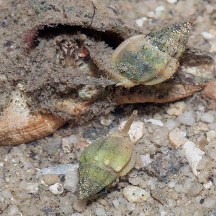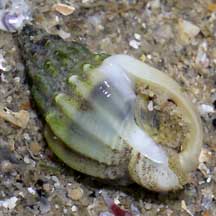Mud
whelk
Nassarius jacksonianus
Family Nassariidae
updated
Aug 2020
Where
seen? A tiny whelk that can be seen busily foraging, especially
at night, on muddy and silty sandy areas near seagrasses on our Northern
shores. Many sometimes seen gathered together grazing on seaweeds,
or on a recently dead sea creature.
Features: 1.5-2cm. Small lumpy-looking
whelk. Shell thick with bumpy ridges on the spire, the front of the shell often with a broad brown band. Body pale with very
long siphon and short tentacles. Operculum thin, pale. |

Tuas, Sep 08 |
|
 Large numbers
cluster on a dead fish.
Large numbers
cluster on a dead fish.
Changi, Jan 07 |
| Whelk food: Whelks are active
scavengers and often seen busily foraging in pools at the change of
the tides. A choice morsel such as a dead crab or fish is a magnet
for these snails which hurry as fast as they can to the feast. |
| Mud
whelks on Singapore shores |
| Other sightings on Singapore shores |

Pulau Ubin OBS, Jan 16
Photo
shared by Marcus Ng on facebook. |
|
|
| Links
References
- Tan Siong
Kiat and Henrietta P. M. Woo, 2010 Preliminary
Checklist of The Molluscs of Singapore (pdf), Lee Kong Chian Natural History Museum, National University of Singapore.
|
|
|




